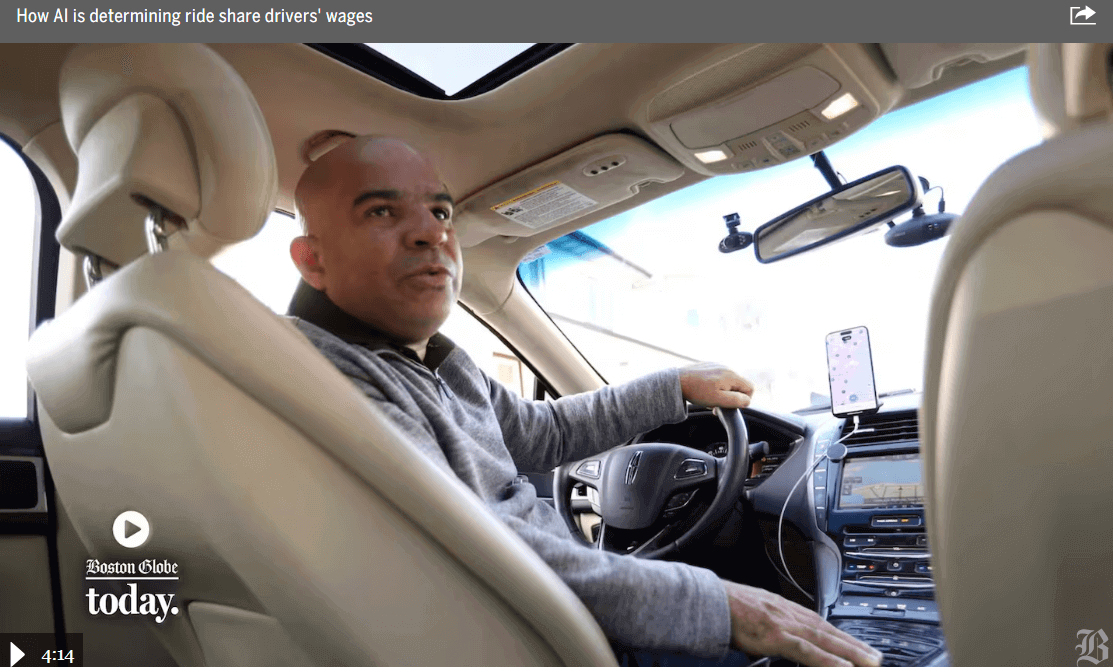一些 Uber 和 Lyft 司机表示,自新最低工资颁布以来,工资有所下降

【中美创新时报2025 年 2 月 10 日编译讯】(记者温友平编译)自从 Uber 和 Lyft 的新最低时薪标准在马萨诸塞州生效以来,他们的整体收入受到了打击。司机们表示,新的收入基础旨在为他们提供更大的稳定性,表面上是让他们有能力赚更多的钱,但相反,他们表示,这似乎起到了某种上限的作用。《波士顿环球报》记者凯蒂·约翰斯顿对此作了下述报道。
拉斐尔不介意努力工作。或者经常开车。这些因素帮助他实现了每周在 Uber 和 Lyft 驾驶时赚取 3,000 美元的目标,促使一位司机给他起了个绰号叫“钢铁侠”。
不过,他说,现在他每周必须投入至少 90 个小时才能达到这个目标。这比他本来就繁重的工作量还要多 10 个小时,在此之前,网约车公司同意在 8 月份为马萨诸塞州司机采用新的最低工资标准,即每小时 32.50 美元。
“情况越来越糟了,”住在波士顿地区的拉斐尔说,他要求不要使用他的姓氏来保护他的工作安全。“以前,情况好多了。”
他并不是唯一一个这样想的人。与新的最低工资标准将提高工资的想法相反,接受《波士顿环球报》采访的许多资深司机表示,自从 Uber 和 Lyft 的新最低时薪标准在马萨诸塞州生效以来,他们的整体收入受到了打击。司机们表示,新的收入基础旨在为他们提供更大的稳定性,表面上是让他们有能力赚更多的钱,但相反,他们表示,这似乎起到了某种上限的作用。
并不是说这些司机的收入低于新的最低工资标准,而是他们想赚更多钱变得更加困难,据 10 名接受《波士顿环球报》采访的当地司机说,其中一些人说,以前,只要稍加努力,他们的平均时薪就能达到 40 美元甚至 50 美元。
“现在,钱的情况非常糟糕,”来自韦斯特伯勒的 41 岁司机赛义德·侯赛因补充道,他表示,越来越多的新订单以如此低的价格提供,以至于不值得接受;他指出,从波士顿郊区到洛根机场的往返行程通常花费不到 20 美元。
到目前为止,对新最低工资前后的收入数据分析有限。但司机指出了几个可能导致收入下降的因素,包括更多的低薪行程和更少的峰值定价,他们说这可以将收入提高 30%。一些人报告说,包括来自马萨诸塞州以外的司机在内的司机数量有所增加,可能是受到新最低工资的承诺所吸引,这意味着不需要使用峰值定价来激励人们上路。
但他们也怀疑有更阴险的东西在起作用:为这些叫车平台提供支持的复杂人工智能算法——批评者说这些算法已经在计算司机可能接受的最低金额——实时调整行程报价以限制司机的工资。行业观察家也同意这一点。
“该系统不断调整,以便让庄家获胜,”布兰迪斯大学教授、奥巴马政府劳工部工资和工时部门负责人大卫·韦尔说。韦尔在马萨诸塞州的诉讼案中担任首席专家,最终促成了新的最低工资协议,在此期间,他对 Uber 和 Lyft 的运营情况有了深入的了解。
Uber 和 Lyft 都表示,自新工资结构生效以来,马萨诸塞州司机的工资总体上有所上涨。Uber 指出,个人司机的工资并没有受到针对性影响。Lyft 表示,它没有看到大量新司机涌入,也没有看到司机的出行次数减少。
Uber 发言人在一份声明中表示:“我们今天定价出行的因素与收入标准实施之前使用的因素相同。”
由于司机的工作时间非常不稳定,因此他们的薪酬结构比普通工人更复杂;首先,司机只有在接受行程并运送乘客后才能获得“活跃”时间的报酬。司机还必须自掏腰包支付汽油和其他费用,这会侵蚀他们的收入。
根据与州政府达成的协议,马萨诸塞州约 87,000 名司机的时薪必须在两周的工资期内平均达到新的最低工资。如果低于这一标准,司机的工资必须补足。(最低工资每年根据通货膨胀进行调整,1 月 15 日上涨至每小时 33.48 美元。)但几名司机告诉《波士顿环球报》,他们注意到,在他们获得远高于最低工资的行程后,他们收到的后续报价会减少,或者会收到一连串低报价,使他们的总收入接近基本工资。
即使在实施新的最低工资标准之前,Uber 和 Lyft 的费率也因供需、时段和其他因素而有所不同;一些司机已经学会了只接收入最高的订单,从而实现收入最大化。但以前每趟订单可获得高达 40 美元的奖励,现在往往只有几美元。
南岸的兼职司机 Matt Reid 就是那些坚持接收入最高的订单的人之一。他的收入仍远高于最低工资,但总体而言,尽管他更挑剔接的订单,但他的时薪现在比以前少了几美元。
“以前,我睡着了就能赚到每小时 50 美元,”他说。“现在我必须拼命争取,赶走那些不称职的司机。”
哥伦比亚商学院驻校高管兼兼职教授 Len Sherman 研究 Uber 薪酬趋势,他分析了 8 月 15 日前后马萨诸塞州少数 Uber 司机的薪酬。没有司机的整体收入增加,有两人的收入下降,尽管他们的收入仍高于新的最低工资标准。
Sherman 发现,他研究的一名司机每小时的工资(基于 2024 年初的 1,624 次行程和去年秋季的 1,123 次行程)下降了 40 多美分,降至 34.40 美元;小费下降了近 18%;每班次的积极驾驶时间减少了近 3%。总而言之,他工作中的每小时总收入在去年最后几个月下降了 5.2%。
Sherman 表示,这是继公司薪酬政策在前一年发生变化后,2023 年司机工资大幅下降之后的结果。
“一些最有经验和最敬业的司机经历了工资削减,这表明每小时 32.50 美元似乎不仅是最低工资,实际上也是最高工资,”谢尔曼说。
Uber 的一位发言人表示,工资因个人驾驶模式和需求波动而有很大差异,并指出只看单个司机的工资“永远没有意义”。
在去年年底约 60 名司机的聚会上进行的一项非正式民意调查中,约有一半人表示,他们认为 Uber 和 Lyft 的算法正在将他们的工资限制在最低工资范围内。
司法部长安德里亚·坎贝尔 (Andrea Campbell) 的发言人表示,坎贝尔的员工知道司机对他们的工资有抱怨,坎贝尔曾在司机错误分类案中协商最低工资,作为和解的一部分。司机们正在组织的工会——这一程序在 11 月得到了选民的批准——表示,提高工资是合同谈判的议程之一。
利用人工智能以闪电般的速度筛选大量数据,实现个性化薪酬的能力可能会远远超出零工经济的范围,这引发了人们对美国企业以牺牲工人为代价赚钱的能力的担忧。通过使用人工智能,以工人几乎看不到的方式,公司越来越多地控制有关薪酬的所有信息,使工人几乎没有能力为自己辩护。
塞尔吉奥·阿维迪安 (Sergio Avedian) 是华尔街的一名退休交易员,现在为 Uber 和 Lyft 开车,也是 The Rideshare Guy 博客的高级撰稿人,他说,自和解以来,他听到许多马萨诸塞州司机抱怨工资降低。这在那些被阿维迪安称为“挑拣者”的人身上尤其明显,他们只接受超过一定金额的行程。
“他们都在向我抱怨:‘塞尔吉,我的收入减少了,’”他说。
根据数据分析公司 Big Lake Data 的数据,2024 年第一季度,近 70% 的马萨诸塞州 Uber 司机每小时的活跃收入超过 32.50 美元。这为工资下调创造了很大的空间。Big Lake Data 创始人 Matt Schumwinger 表示,有整整两周的时间来平衡工资以达到最低工资标准,这让公司在定价方面有了回旋余地;如果他们需要让更多司机上路,他们就有更大的空间相应地提高工资。
Schumwinger 说,如果更多司机接受低薪行程,算法就会继续将他们淘汰。这可以作为工资的锚,将整体平均工资降至尽可能接近最低工资。
对于每周工作时间超过 90 小时的波士顿司机 Rafael 来说,工资下降了很多,他说,他现在每天要开车 13 到 14 个小时,才能达到每周的目标。
Rafael 对减薪并不感到惊讶。他说,公司就是这样做的。作为一名前酒店厨师,他习惯了长时间工作。
“自从我来到美国,我一生都在努力工作以维持生计,”拉斐尔说,他来自南美,已经在 Uber 和 Lyft 开车十年了。
所以他埋头苦干,开着应用程序,攒钱开始他的下一个篇章:成为一名商业航空公司飞行员。
本文由《波士顿环球报》的“金钱、权力和不平等”团队撰写,该团队负责报道大波士顿地区的种族财富差距。
题图:记者凯蒂·约翰斯顿解释了这项技术及其未来的影响。
附原英文报道:
Some Uber, Lyft drivers say pay has declined since new minimum wage enacted
By Katie Johnston Globe Staff,Updated February 4, 2025
Reporter Katie Johnston explains the technology and the future implications.
Rafael doesn’t mind working hard. Or driving a lot. That combination has helped him reach his goal of earning $3,000 a week behind the wheel for Uber and Lyft, prompting a fellow driver to give him the nickname “Ironman.”
These days, though, he said, he has to put in at least 90 hours a week to reach that amount. That’s 10 hours more than his already hefty workload before the ride-hailing companies agreed to adopt a new minimum wage for Massachusetts drivers in August, at $32.50 an hour.
“It’s getting worse and worse,” said Rafael, who lives in the Boston area and asked that his last name not be used to protect his job security. “Before, it was much better.”
He’s not alone. Contrary to the idea that the new minimum wage would increase pay, a number of veteran drivers interviewed by The Boston Globe said their overall earnings have taken a hit since Uber and Lyft’s new minimum hourly wage went into effect in Massachusetts. Intended to give them greater stability and, ostensibly, the ability to make more money, drivers said that instead the new earnings base seems to be functioning as a cap of sorts.
It’s not that these drivers are making below the new minimum — it’s that it has become much harder to make more, according to 10 local drivers who talked to the Globe, some of whom said that, previously, with a little effort, they could average $40 or even $50 an hour.
“Right now, the situation for the money, it’s very bad,” added Syed Hussain, 41, a driver from Westborough who said that increasingly, new rides are being offered at such low rates they aren’t worth accepting; trips to Logan Airport from the Boston suburbs, he noted, routinely come in under $20.
So far, data analysis of earnings before and after the new minimum wage is limited. But drivers point to several factors that could be contributing to the earnings pinch, including more low-paying rides and less surge pricing, which they say can boost earnings by up to 30 percent. Some report an increase in drivers, including from outside Massachusetts, possibly attracted by the promise of the new minimum wage, which would mean less need to use surge pricing to incentivize people to get on the road.
But they also suspect something more insidious at play: the sophisticated AI-powered algorithms that power these ride-hailing platforms — which critics say were already calculating the lowest amount drivers would likely accept — adjusting trip offers in real time to limit drivers’ pay. And industry observers agree.
“The system is constantly adjusting in order to let the house win,” said David Weil, a Brandeis University professor who ran the Department of Labor’s wage and hour division in the Obama administration. Weil got an inside glimpse at Uber and Lyft’s operations when he served as the lead expert for the State of Massachusetts in its lawsuit that resulted in the new minimum wage deal.
Both Uber and Lyft said driver pay in Massachusetts has gone up overall since the new wage structure went into effect. Individual drivers’ wages aren’t being targeted, Uber noted. Lyft said it hadn’t seen a major influx of new drivers or drivers getting fewer trips.
“The factors we rely on for pricing trips today are the same factors we used before the earning standard was in place,” an Uber spokesperson said in a statement.
Since working hours for drivers are so fluid, the pay structure is more complicated than for a typical worker; for one, drivers are only paid for “active” time after they’ve accepted a trip and are transporting passengers. Drivers must also pay for gas and other expenses out of pocket, which eats into their earnings.
Under the agreement with the state, the hourly pay of the estimated 87,000 drivers in Massachusetts has to average out to the new minimum over a two-week pay period. If it’s below that, driver pay must be topped off. (The minimum, which is adjusted every year for inflation, went up to $33.48 an hour Jan. 15.) But several drivers told the Globe they’ve noticed that after they get a trip well above the minimum wage, they receive fewer subsequent offers, or a string of low ones, bringing their overall earnings down closer to the base amount.
Even before the new minimum wage was enacted, rates at Uber and Lyft varied depending on supply and demand, time of day, and other factors; some drivers have learned to maximize their earnings by accepting only the highest-paying trips. But incentives that used to tack on as much as $40 to a trip are now often just a few dollars.
Matt Reid, a part-time driver on the South Shore, is among those who hold out for the highest-paying rides. He still makes far more than the minimum rate, but overall, his hourly pay is now several dollars less than before, despite the fact that he’s being choosier about which trips he accepts.
“Before, I could get $50 an hour in my sleep,” he said. “Now I have to fight like crazy, swatting away the bad ones.”
Len Sherman, an executive in residence and adjunct professor at Columbia Business School who studies Uber pay trends, analyzed the pay of a handful of Massachusetts Uber drivers before and after Aug. 15. None saw an increase in overall earnings, and two saw their earnings decline, though they all still made more than the new minimum wage.
Sherman found that for one driver he studied, his pay per active hour — based on more than 1,624 trips in early 2024 and 1,123 last fall — went down by more than 40 cents an hour, to $34.40; his tips dropped nearly 18 percent; and his active driving time per shift declined by almost 3 percent. All told, his total earnings per hour on the job fell 5.2 percent in the last few months of the year.
This follows a steep drop in driver pay in 2023 after a change in the company’s pay policy the year before, Sherman said.
“Some of the most experienced and dedicated drivers have experienced a pay cut, indicating that the $32.50 per active hour seems to be serving not just as a floor but, in effect, as a ceiling as well,“ Sherman said.
A spokesperson for Uber said that pay varies widely depending on individual driving patterns and fluctuating demand, noting that looking at a single driver’s pay is “never informative.”
In an informal poll taken during a gathering of about 60 drivers late last year, about half said they thought Uber and Lyft’s algorithms were working to limit their pay to the minimum wage.
A spokesperson for Attorney General Andrea Campbell, who negotiated the minimum wage as part of a settlement in a driver misclassification case, said that Campbell’s staff is aware of complaints from drivers about their pay. The union the drivers are organizing — a process approved by voters in November — said improving pay was on the agenda for contract negotiations.
The ability to individualize pay using artificial intelligence to sift through mountains of data at lightning speed could spread far beyond the gig economy, raising concerns about corporate America’s ability to make money at the expense of workers. By using AI, in ways that are all but invisible to workers, companies increasingly control all the information about pay, leaving workers little ability to advocate for themselves.
Sergio Avedian, a retired trader on Wall Street who now drives for Uber and Lyft and is a senior contributor to The Rideshare Guy blog, said he’s heard from a number of Massachusetts drivers complaining about lower wages since the settlement. It’s especially apparent among those Avedian refers to as the “cherry pickers,” who only accept trips above a certain amount.
“They’re all complaining to me: ‘Serge, I’m getting an earnings cut,‘” he said.
Nearly 70 percent of Massachusetts Uber drivers were making more than $32.50 per active hour in the first quarter of 2024, according to the data analytics company Big Lake Data. This creates a lot of space for downward movement. Having a full two weeks to even out pay to hit the minimum wage gives the companies leeway in pricing rides, said Big Lake Data founder Matt Schumwinger; they then have more room to bump wages up accordingly if they need to get more drivers on the road.
If more drivers accept lower-paying trips, the algorithm will keep spitting them out, Schumwinger said. This could act as an anchor on wages, bringing down the overall average to as close to the minimum as possible.
For Rafael, the 90-plus-hour-a-week driver in Boston, pay has dropped so much, he said, that he’s now driving 13 or 14 hours a day, every day, to hit his weekly goal.
Rafael wasn’t surprised by the pay cut. That’s what companies do, he said. And as a former hotel chef, he’s used to working long hours.
“My whole life since I’ve been in America I’ve been working hard to make ends meet,” said Rafael, who is from South America and has been driving for Uber and Lyft for a decade.
So he’s keeping his head down, and his apps on, to save money to begin his next chapter: becoming a commercial airline pilot.
This story was produced by the Globe’s Money, Power, Inequality team, which covers the racial wealth gap in Greater Boston.

